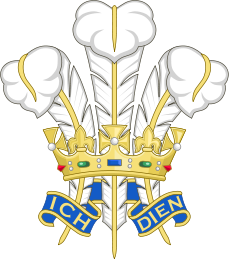Vauxhall Motors
 |
|
| Type | private limited company |
|---|---|
| Industry | Automotive |
| Predecessor | Alex Wilson and Company, then Vauxhall Iron Works |
| Founded | 1857 (Vauxhall ironworks making river boat engines)[1] 1903 (as a horseless carriage manufacturer)[1] |
| Founder(s) | Alexander Wilson |
| Headquarters | Luton, United Kingdom |
| Number of locations | Production site at |
| Area served | United Kingdom |
| Key people | Duncan Aldred (MD) |
| Products | Automobiles |
| Services | Automotive financial services (GMAC) |
| Revenue | £3,785 million (2004)[2] |
| Operating income | £131 million (2004)[2] |
| Profit | £-176 million (2004)[2] |
| Owner(s) | General Motors |
| Employees | 4.700 (2009)[2] |
| Parent | General Motors |
| Divisions | VXRacing |
| Website | Vauxhall.co.uk |
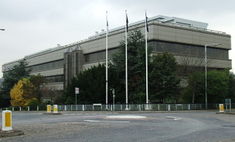
Vauxhall Motors (pronounced /ˈvɒksɔːl/) is a British car manufacturer, owned by General Motors. Most current Vauxhall models are right-hand drive derivatives of Opel, GM's German company. However, production of left-hand drive vehicles also takes place for export to other parts of Europe, and certain marginal markets. There are also several performance vehicles coming from Opel Performance Center (OPC) and Holden/Holden Special Vehicles in Australia. Vauxhall is headquartered in the Griffin House in Luton.[3]
In early 2009, the future of Opel was thrown into uncertainty as the global financial crisis drove GM towards bankruptcy. New GM Europe (Vauxhall plus Opel, minus Saab),[4] is presently controlled by a trustee, with a controlling board made up of representatives from GM, employees and the German Government; the company was subject to a bidding process.
On 10 September 2009, it was announced that Magna, a Canadian car part manufacturer, and Sberbank, a Russian company, would buy a majority stake (55%) in its European Opel/Vauxhall operations. GM would have owned 35% of Opel; while Opel employees would have owned 10%. The agreement would have kept Opel/Vauxhall a fully integrated part of GM’s global product development organisation, allowing all parties to benefit from the exchange of technology and engineering resources.[5] On 3 November 2009, the GM board called off the Magna deal, after coming to the conclusion that Opel and Vauxhall Motors are crucial to GM's global strategy.
Duncan Aldred was appointed to the role of Managing Director of Vauxhall, in January 2010.
Contents |
History
Alexander Wilson founded the company in the Dusian Road, Vauxhall, London in 1857. Originally named Alex Wilson and Company, then Vauxhall Iron Works, the company built pumps and marine engines. In 1903, the company built its first car, a five-horsepower model steered using a tiller, with two forward gears and no reverse gear. This led to a better design which was made available for sale.
To expand, the company moved the majority of its production to Luton in 1905. The company continued to trade under the name Vauxhall Iron Works until 1907, when the modern name of Vauxhall Motors was adopted. The company was characterised by its sporting models, but after World War I the company's designs were more austere.
Before GM
Much of Vauxhall's success during the early years of Vauxhall Motors was due to a man called Laurence Pomeroy. Pomeroy joined Vauxhall in 1906 as an assistant draughtsman, at the age of twenty-two. In the winter of 1907/8, the chief designer F.W. Hodges took a long holiday, and in his absence the managing director Percy Kidner asked Pomeroy to design an engine for cars to be entered in the 1908 RAC and Scottish Reliability Trial, held in June of that year. The cars were so successful that Pomeroy took over from Hodges.[6]
His first design, the Y-Type Y1, had outstanding success at the 1908 RAC and Scottish 2000 Mile Reliability Trials - showing excellent hill climbing ability with an aggregate of 37 seconds less time in the hill climbs than any other car in its class. With unparalleled speeds around the Brooklands circuit, the Vauxhall was so far ahead of all other cars of any class that the driver could relax, accomplishing the 200 miles (320 km) at an average speed of 46 mph (74 km/h), when the car was capable of 55 mph (89 km/h). The Y-Type went on to win class E of the Trial.
The Y-Type was so successful that it was decided to put the car into production as the A09 car. This spawned the legendary Vauxhall A-Type. Four distinct types of this were produced between 27 October 1908 - up to when mass production halted in 1914. One last A-Type was put together in 1920. Capable of up to 100 mph (160 km/h), the A-Type Vauxhall was one of the most acclaimed 3 litre cars of its day.
Two cars were entered in the 1910 Prince Henry Trials, and although not outright winners, performed well, and replicas were made for sale officially as the C-type - but now known as the Prince Henry.
During World War I, Vauxhall made large numbers of the D-type, a Prince Henry chassis with de-rated engine, for use as staff cars for the British forces.
After the 1918 armistice, the D-type remained in production, along with the sporting E-type. Pomeroy left in 1919, moving to the United States, and was replaced by C.E. King.[6] In spite of making good cars, expensive pedigree cars of the kind that had served the company well in the prosperous pre-war years were no longer in demand:[1] the company struggled to make a consistent profit and Vauxhall looked for a major strategic partner.
GM purchase
In 1925, Vauxhall was bought by GM for US$2.5 million. The company's pre-war image and target market were abruptly changed - with the introduction in 1931 of the first Bedford truck, which was Chevrolet based, along with the low-cost two litre Vauxhall Cadet.[1] The company's future chief engineer, Harold Drew, left Luton for a spell working as a draughtsman with GM's Lansing based Oldsmobile division.[1] As the first significant post acquisition passenger car, the Cadet, initially retailing at GB£280, is generally mentioned in connection with Vauxhall's newly acquired interest and expertise in controlling production costs, but it was also noteworthy as the first British car to feature a synchromesh gearbox.[1]
The influence of the American parent was pervasive, and together with the Ford Motor Company, Vauxhall's main competitor, led to a wave of American influenced styling in Europe that persisted through to the 1980s. Bedford Vehicles, a subsidiary constructing commercial vehicles, was established in 1930 as the Stock Market Crash of 1929 had made importing American trucks uneconomical.
Second World War
During World War II, car production at Luton was suspended to allow Vauxhall to work on the new Churchill tank, taking it from specification to production in less than a year, and assembled there (as well as at other sites). Over 5,600 Churchill tanks were built. Luton also produced lorries for the war effort (250,000), the Bedford designs being common in British use.
Post World War II
After the war, car production resumed, but models were designed as a more mass-market product leading to expansion of the company. A manufacturing plant at Ellesmere Port was built in 1960.[7] During the 1960s, Vauxhall acquired a reputation for making rust-prone models, though in this respect, most manufacturers were equally bad. The corrosion protection built into models was tightened up significantly, but the reputation dogged the company until the early 1980s.
By the late 1960s, the company was achieving five-figure sales on its most popular models, including the entry-level Viva and larger Victor.
1970s and 1980s
Vauxhall's fortunes improved during the 1970s, with an updated version of the Viva continuing to sell in huge volumes.
By 1973, however, the Victor was losing sales in a market that was becoming increasingly dominated by the Ford Cortina. The Viva was still among the most popular cars in Britain, as a facelift in 1970 stopped the design from becoming too outdated. But this wasn't enough to keep Vauxhall from being well behind market leaders Ford and British Leyland in the sales charts, and most of its range was struggling even to keep pace with Chrysler UK (formerly the Rootes Group). Vauxhall's sales began to increase in 1975, with the launch of two important new models - the Chevette, a small three-door hatchback that was the first car of its kind to be built in Britain, the Chevette carrying the name Opel Kadett in Europe, and Chevrolet Chevette in the US market; and the Cavalier (Opel Ascona elsewhere), a stylish four-door saloon designed to compete head-to-head with the all-conquering Ford Cortina. By the end of the 1970s, Vauxhall had boosted its market share substantially, and was fast closing in on Ford and British Leyland.
By 1979, Vauxhall had increased its market share substantially, but was still some way behind Ford and British Leyland, even though it had overtaken Talbot (the successor organisation to Rootes and Chrysler UK). At the end of 1979, Vauxhall moved into the modern family hatchback market with its Astra, (Opel Kadett elsewhere) range that replaced the ageing Viva and Chevette models. The Astra quickly became popular with buyers, but the 1981 Mk2 Cavalier - the first Vauxhall of this size to offer front-wheel drive and a hatchback bodystyle - was the car that really boosted Vauxhall's fortunes. The 1983 Nova (Opel Corsa elsewhere) supermini, an addition to the Vauxhall line up, completed Vauxhall's regeneration, and it soon overtook Austin Rover (formerly British Leyland) as Britain's second most popular carmaker. The Astra further strengthened its position in the market with an all-new 1984 model that featured an aerodynamic design reminiscent of Ford's larger Sierra.
Vauxhall's most important model of the 1980s was the 1981 Mk2 Cavalier, which made the transition from rear-wheel drive saloon to front-wheel drive hatchback (though there was still a saloon version available, complemented in 1983 with an estate). For much of its life, it was Britain's most popular large family car, vying with the Ford Sierra for top place. The Cavalier was relaunched in 1988, an all-new format which won praise for its sleek looks and much-improved resistance to rust.
The range then was extended by the Senator (Opel Omega elsewhere). The Cavalier (Mk3) entered its third generation in 1988 - with an all-new sleek design that further enhanced its popularity. The Calibra coupé followed in 1989, which was officially the most aerodynamic production car in the world on its launch. Falling between the Cavalier and Senator, was the Carlton (Opel Omega elsewhere) - relaunched in 1986, and was voted European Car of the Year, a large four-door family saloon. There were two sports versions of the Carlton, the 3000 GSi, and the Lotus Carlton - aimed a family minded executives. The later being considered as the fastest four-door production car, at the time. Most importantly, the latest generation of Vauxhall models had eradicated the image of rusting cars that for so long had put potential buyers off the Vauxhall brand.
By 1989, Vauxhall was on something like equal terms with the Rover Group as Britain's second most popular car brand behind Ford.
1990s
In 1993, things were still looking strong for Vauxhall. The Cavalier was firmly re-established as Britain's most popular large family car, with more than 130,000 sales, while the third generation Astra (relaunched in 1991) with 100,000 sales was continuing to narrow the gap between itself and the best-selling Ford Escort. The Astra was now joined by the Belmont - a four-door booted version of the Astra. This continued for some time until being renamed Astra, presumably to provide combined sales/registration figures. The decade-old Nova was axed in 1993, in favour of the all-new Corsa, adopting the European naming of the model; its distinctive styling and practical interior began attracting more sales than its predecessor had done.
In 1994, GM ceased production of Bedford Vehicles, which had been Vauxhall's commercial vehicle arm, making successful vans, trucks and lorries since the 1930s. Van production continued at Luton, now under the Vauxhall name.
The Cavalier nameplate was axed in 1995 after 20 years, and Vauxhall adopted the Vectra nameplate for its successor, completing a policy by General Motors that aligned and identically badged all Vauxhall and Opel models. Vectra received disappointing feedback from the motoring public, and several well-known journalists, most notably Jeremy Clarkson. Yet it was still hugely popular, and for a while after the 1999 facelift, it was actually more popular than Ford's highly-acclaimed Mondeo. The Astra entered its fourth generation in 1998, and offered levels of build quality and handling that bettered all of its predecessors.[8]
It was around this time that Vauxhall was being heavily criticised in several high profile car surveys. In 1998, a Top Gear customer satisfaction survey condemned the Vauxhall Vectra as the least satisfying car to own in Britain. A year later, as a brand Vauxhall was slated as the least satisfying make of car by the same magazine's customer satisfaction survey. Its model range came in for heavy criticism for breakdowns, build quality problems, and many other maladies - which meant that quality did not reflect sales success. Despite this, Vauxhall was competing strongly in the sales charts, and by 1999, was closer to Ford in terms of sales figures than it had been in years.
21st century
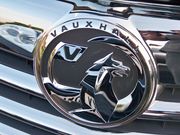
The first years of the 21st century saw Vauxhall further strengthen its position in the British market, and continue to narrow the gap with Ford. The Corsa was regenerated in 2000, and offered a better-handling, better-built and better-equipped package than ever before.
2002 was one of the best years ever for Vauxhall sales in the UK. The updated Corsa (launched in 2000) was Britain's second most popular new car, and gave the marque top spot in the British supermini car sales charts for the very first time. The Astra was Britain's third best selling car that year, while the Vectra and the Zafira (a compact MPV launched in 1999) lurked just outside the top ten with relatively strong sales.
The Vectra entered its second generation in 2002 and was further improved over earlier Vectras, but was still hardly a class-leader, and now had to be content with lower sales due to a fall in popularity of D-sector cars; although a facelift in 2005 sparked a rise in sales.
Perhaps the most important Vauxhall product of the 2000s so far is the fifth generation Astra, launched in early 2004 - and praised by the motoring press for its dramatic styling, which was a world of difference from the relatively bland previous Astra. It was an instant hit with British buyers, and was the nation's second best selling car in 2005 and 2006, giving the all-conquering Ford Focus its strongest competitor yet. Many UK Police forces have also adopted the Astra as the standard patrol vehicle. The second generation Vectra went on sale during 2002, but has not sold as strongly as its predecessor. Its successor, called the Insignia premiered at the 2008 British International Motor Show at ExCeL London. It is hoped that it will give Vauxhall a fresh new competitor in a sector which has shrunk considerably in Britain over the last few years.
The second generation Corsa had been Britain's most popular supermini for most of its production life, but by 2006 it had started to fall behind the best of its competitors, so an all-new model was launched. This Corsa sold far better than either of the previous Corsas, and it was an instant hit with buyers.
In 2006, the second generation Zafira was Britain's 10th best selling car. It was the first time that an MPV had featured in the top 10 best-selling cars in Britain.
For GM's former management, the Prius came as a wake-up call, though by the time they unveiled their own petrol-electric concept car at the Detroit motor show in January 2007, it was widely agreed that they were late to the party.
The Ampera E-Rev, short for extended range electric vehicle, is a Vauxhall with a 16 kWh, 400 lb (180 kg) lithium-ion battery pack that delivers 40 miles (64 km) of motoring and a 1.4 litre petrol engine that extends the car's range to 350 miles (560 km).
Opel/Holden relationship
From the 1970s, most models were based on models made by Opel in Germany. The Chevette, Cavalier and Carlton were basically restyled versions of the Kadett, Ascona and Rekord, featuring a distinctive sloping front end, nicknamed the "droopsnoot", first prototyped on the HPF Firenza. The Carlton/Viceroy and Royale were simply rebadged versions of Opel's Opel Commodore C and Senator, imported from Germany.
This was the starting point for the "Opelisation" of Vauxhall. With the 1979 demise of the Viva, GM policy was for future Vauxhall models to be, in effect, rebadged Opels, designed and developed in Rüsselsheim, with little engineering input from Luton. In the late '70s and early '80s, GM dealers in the United Kingdom and the Republic of Ireland sold otherwise identical Opel and Vauxhall models alongside each other. This policy of duplication was phased out, beginning with the demise of Opel dealerships in the UK in 1981. The last Opel car (the Manta coupe) to be "officially" sold in Britain was withdrawn in 1988.
Similarly, the Vauxhall brand was dropped by GM in Ireland in favour of Opel in 1982, with other right hand drive markets like Malta and Cyprus soon following suit. In New Zealand, the brand was withdrawn in favor of Holden after the demise of the Chevette. Many new Opel-badged cars have been privately imported into the UK from Ireland, and other EU countries, while many Vauxhalls have been imported second hand into Ireland.
GM Europe then began to standardise model names across both brands in the early 1990s. The Vauxhall Astra and Opel Kadett, for example, were both called Astra from 1991 onwards; the Vauxhall Cavalier and Opel Vectra were both called Vectra from 1995 etc. With the exception of the VX220, sold by Opel as the Speedster, all of Vauxhall's models now have the same names as those of Opel.
Since 1994, Vauxhall models differ from Opels in their distinctive grille - featuring a "V", incorporating the Vauxhall badge. This has also been used by Holden in New Zealand, by Chevrolet in Brazil on the Mk1 Chevrolet Astra (Opel Astra F) and on the Indian version of the Opel Astra. The "V" badging is an echo of the fluted V-shaped bonnets that have been used in some form on all Vauxhall cars since the very first. The "V" grille is not however used on the Vectra-replacing Insignia, unveiled in 2008 and the 2009 Vauxhall Astra and the 2010 Vauxhall Meriva.
A model unique to the Vauxhall range is the high performance Monaro coupé, which is sourced from and designed by Holden in Australia. Although this model is also produced in left hand drive (LHD) for markets like the U.S. (known as the Pontiac GTO) and in the Middle East and South Africa (known as the Chevrolet Lumina), the model is not currently offered by Opel in mainland Europe. Imports of this vehicle are limited to 15,000 to avoid additional safety testing. A future vehicle that Opel has not confirmed, but Vauxhall has, is the Holden Commodore SSV and the HSV GTS. The SSV has a GM 6.0 L98 V8, and the HSV uses the high performance GM 6.0 LS2 V8. Both are on the new GM Zeta platform, which will underpin many future full-size GM vehicles. Vauxhall confirmed the import of the HSV just after the reborn Opel GT roadster was announced as not being imported into the UK. Vauxhall claim the Vauxhall Commodore and HSV will replace the Monaro, and be far more aggressively styled than the HSV, and have several defining Vauxhall features.
The bodywork for the Holden Camira estate was used for the Vauxhall Cavalier estate in the UK (though not for the identical Opel Ascona in the rest of Europe) - conversely the rear bodywork of the T-car Vauxhall Chevette estate and Bedford Chevanne van was used for the respective Holden Gemini versions. Vauxhall's compact car, the Viva, formed the basis of the first Holden Torana in Australia in the 1960s.
Many cars badged as Opels, even LHD models, are produced by Vauxhall for export. Vauxhall has built some Holdens for export, too, notably Vectra-As to New Zealand and Astra-Bs to both Australia and New Zealand.
Closures and restructuring
Vauxhall announced on 12 December 2000, that car production at Luton would cease in 2002, with the final vehicle being made in March 2002 following the end of production of the Vectra B and the moving of its replacement to Ellesmere Port alongside the Astra. Manufacture of vans (sold under the Vauxhall, Opel, Renault and Nissan badges throughout Europe) continues at the IBC Vehicles plant in Luton.
On 17 May 2006, Vauxhall announced the loss of 900 jobs from Ellesmere Port's 3,000 staff. Despite already meeting efficiency targets, Vauxhall has been told to further improve productivity. Vauxhall's troubled parent GM is cutting 30,000 jobs in the United States.[9]
Cancelled sale to Magna
On 30 May 2009, a deal was announced which will lead to the spin-off of the Opel and Vauxhall brands into a new company. On the 1st June 2009, Vauxhall Motors troubled parent company, General Motors filed for bankruptcy in a court in New York. By then the sale of Vauxhall and its sister subsidiary, Opel, was being negotiated as part of a strategy driven by the German government to ring fence the businesses from any General Motors asset liquidation.[10][11][12][13]
The sale to Canadian-owned Magna International was agreed on 10 September 2009, with the approval of the German government.[5] During the announcement regarding the sale, Magna promised to keep the Vauxhall factory at Ellesmere Port open until 2013, but could not guarantee any further production after that date.[14] On 3 November 2009, the GM board called off the Magna deal after coming to the conclusion that Opel and Vauxhall Motors was crucial to GM's global strategy.[15]
VXRacing
The VXR range is analogous to the OPC range made by Opel Performance Center, the HSV range made by Holden and the SS range made by Latin America Chevrolet. The models include the Corsa VXR, Astra VXR, Insignia VXR, Meriva VXR, Zafira VXR, VXR8, VX220 (no longer in production), and the Australian-built Holden Monaro (also no longer in production). These vehicles are high performance machines, and are ideally aimed for younger buyers. Vauxhall unveiled a new model based on the Australian HSV Maloo at the 2005 National Exhibition Centre motor show in Birmingham, England. It was claimed that the monstrous V8 Ute had a top speed around 200 mph (320 km/h) - which is extremely fast for a utility vehicle. However, the model never got to the showroom in the United Kingdom. The Monaro is also no longer made, but a new version (a four door saloon) is now on sale called the VXR8. The VXR8 is based on Australia's Holden HSV Clubsport R8. This car reaches 0-60 in 5 seconds, in similar territory to other muscle car contemporaries such as the Dodge Viper (SRT-10) and Corvette Z06 - and marginally slower than Fords FG F6 Falcon. The VXR badge is a symbol of the combined technological resources of the global General Motors group, and the recognised expertise of consultants Lotus and the Triple Eight Racing Team.
Origins of the name and the logo

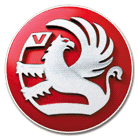
The griffin emblem, which is still in use, is derived from the coat of arms of Falkes de Breauté, a mercenary soldier who was granted the Manor of Luton for services to King John in the thirteenth century. By marriage, he also gained the rights to an area near London, south of the Thames. The house he built, Fulk's Hall, became known in time as Vauxhall. Vauxhall Iron Works adopted this emblem from the coat of arms to emphasise its links to the local area. When Vauxhall Iron Works moved to Luton in 1905, the griffin emblem coincidentally returned to its ancestral home.
The logo as pictured used to be square, but it is now circular, to enable it to fit in the same recess designed for the circular Opel emblem. Since the 1920s, the griffin has been redesigned and released 9 times. 2008 saw the release of a revised version of the 2005 logo. Bill Parfitt, Chairman and Managing Director of GM UK, said, "While the new-look Griffin pays homage to our 100 year-plus manufacturing heritage in the UK, it also encapsulates Vauxhall’s fresh design philosophy, first showcased in the current Astra, and set to continue with Insignia."[16]
Customer Service & Social Media
Vauxhall motors is the first European motor manufacturer to offer customer care and after sales assistance, via social media websites. Their official Twitter page - @VauxhallCustSvc - was launched in June 2010 and they are actively helping customers through social networking.
Sponsorship
Vauxhall Motors sponsored the Football Conference, the highest non-league division of English football, from 1986 until 1998. It took over from Gola, and remained in association with the league for twelve years, before ending its backing and being replaced by Nationwide Building Society.
List of vehicles

Vauxhall 30/98 Special 1923
|
|
Vauxhall 14: 6 cyl 4-door Saloon 1937
|
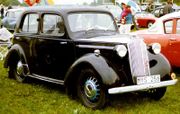
Vauxhall 10: 4 cyl 4-door Saloon 1938
|

Vauxhall Wyvern 4-door Saloon
|
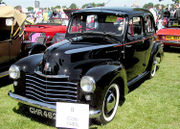
1949 Vauxhall Wyvern (L series)
|

Vauxhall Velox 4-door Saloon 1955
|

Vauxhall Velox 4-door Saloon 1958
|
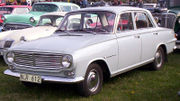
Vauxhall FBD Victor 4-door Saloon 1963
|
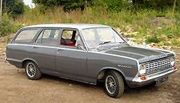
1965 Vauxhall Victor FC 101 Estate
|

1970 Vauxhall SRV concept
|

1970s Vauxhall Firenza HPF
|

1985 Vauxhall Belmont
|
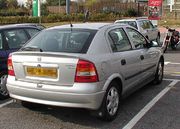
2000 Vauxhall Astra
|
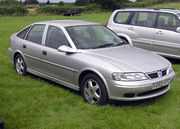
2000 Vauxhall Vectra
|
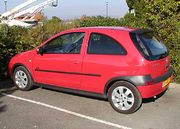
2003 Vauxhall Corsa
|
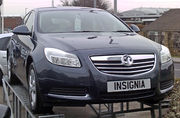
2009 Vauxhall Insignia
|
Current cars
- Vauxhall Agila (2000–present)
- Vauxhall Ampera (2011–present)
- Vauxhall Antara (2007–present)
- Vauxhall Astra (1980–present) rebadged Opel Kadett D/E (Mk 1 & 2) / Opel Astra (Mk 3 onwards)
- Vauxhall Corsa (1993–present)
- Vauxhall Insignia (2008–present)
- Vauxhall Meriva (2003–present)
- Vauxhall VXR8 (2007–present) rebadged HSV E-series
- Vauxhall Zafira (1999–present)
Former cars
- Vauxhall 10-4 (1937–1947)
- Vauxhall 12-4 (1937–1946)
- Vauxhall 14-6 (1935–1948)
- Vauxhall 14 and 14/40 (1922–1927)
- Vauxhall 20/60 (1927–1930)
- Vauxhall 23/60 (1922–1926)
- Vauxhall 25 (1937–1940)
- Vauxhall 25/70 (1926–1928)
- Vauxhall 30/98 E-type (1913–1922)
- Vauxhall A-Type (1911–1914)
- Vauxhall B-type (1910–1914)
- Vauxhall C-type "Prince Henry" (1911–1913)
- Vauxhall D-type (1913–1922)
- Vauxhall Albany
- Vauxhall Belmont (1986–1991)
- Vauxhall Cadet (1931–1933)
- Vauxhall Calibra (1989–1997)
- Vauxhall Carlton (1978–1994) rebadged Opel Rekord (Mk 1) / Opel Omega (Mk 2)
- Vauxhall Cavalier (1975–1995) rebadged Opel Ascona (Mk 1 & 2) / Opel Vectra (Mk 3)
- Vauxhall Chevette (1975–1984) rebadged Opel Kadett C
- Vauxhall Cresta (1954–1972)
- Vauxhall Envoy (1960–1970) see Victor
- Vauxhall Epic (1963–1970) see Viva
- Vauxhall Equus (1978 concept)
- Vauxhall Firenza (1970–1975)
- Vauxhall Frontera (1991–2004, rebadged Isuzu MU Wizard)
- Vauxhall Magnum (1973–1978)
- Vauxhall Monaro (2001–2005) rebadged Holden Monaro
- Vauxhall Monterey (1994–1998, rebadged Isuzu Trooper)
- Vauxhall Nova (1983–1993), rebadged Opel Corsa A
- Vauxhall Omega (1994–2003), rebadged Opel Omega B
- Vauxhall Senator | Vauxhall Royale (1978–1986), rebadged HSV/Opel Opel Senator
- Vauxhall Senator (1978–1994)
- Vauxhall Signum (2003–2008)
- Vauxhall Silver Aero (1983 concept)
- Vauxhall Silver Bullet (1976 concept)
- Vauxhall Six (1933–1938)
- Vauxhall SRV (1970 concept)
- Vauxhall T and T80 (1930–1932)
- Vauxhall Tigra (1994-2000 2004-2009)
- Vauxhall Vectra (1995–2008)
- Vauxhall Trixx (Not yet released)
- Vauxhall Velox (1948–1965)
- Vauxhall Ventora (1968–1972)
- Vauxhall Viceroy (1978–1982), rebadged Opel Commodore
- Vauxhall Victor (1957–1972)
- Vauxhall Viscount (1966–1972)
- Vauxhall Viva (1963–1979)
- Vauxhall VX220 (2001–2005)
- Vauxhall VX4/90 (1961–1972) performance version of Victor
- Vauxhall VX Lightning (limited edition VX220)
- Vauxhall Wyvern (1948–1957)
Vans
- Bedford Beagle (1964–1973)
- Bedford Astramax (1984–1992)
- Bedford Rascal (1986–1993, rebadged Suzuki Supercarry)
- Bedford CF Van
- Bedford Midi
- Bedford Dormobile
- Vauxhall Sintra (1996–1999, rebadged Chevrolet Venture)
- Vauxhall Arena (1997–2000, rebadged Renault Trafic)
- Vauxhall Combo (1994–present)
- Vauxhall Movano (1999–present)
- Vauxhall Vivaro (2001–present)
Timeline
1857 — Marine engineer Alexander Wilson founded the Vauxhall Ironworks in Lambeth, London, and named after the Vauxhall district of Lambeth.[6]
1903 — The company joined the horseless carriage business, building several tiller-steered single cylinder vehicles without having a reverse gear, of which a single survivor could still be seen at the London Science Museum in 1968.[1]
1905 — Vauxhall builds a factory at Luton where, from 1907, most of its vehicle production will be completed.[6]
1907 — Vauxhall Motors Limited formed, based at Luton, and named after the residential area in which its predecessor company was formed.[1][6]
1925 — Vauxhall becomes part of the American automotive combine General Motors.
1930 — Bedford Vehicles - the commercial vehicle arm of Vauxhall Motors - is founded.
1960 — Vauxhall builds a new factory at Ellesmere Port.
1963 — Production of the Vauxhall Viva small family car commences, with the new car being aimed at the likes of the Ford Anglia and Morris Minor. The German version of the car will be sold as the Opel Kadett. The locally assembled Vauxhall Viva will be launched in Australia in May 1964.
1966 — Vauxhall's Slant Four goes into production - the first production overhead camshaft inline-four engine to use a rubber timing belt. Also the FD Victor is launched at the Earls Court Motor Show, considered by many to be one of Vauxhall's finest all-British styling efforts.
1970 — The HC Viva is launched, which went on to become Vauxhall's best-selling car of the decade.
1973 — The Vauxhall Firenza "Droopsnoot" is unveiled at the Earls Court Motor Show, introducing the public to Vauxhall's new aerodynamic look for all of its subsequent 1970s models.
1974 — Vauxhall moves into the mini-car sector with the introduction of its Chevette, a rear-wheel drive range of hatchbacks, saloons and estates. It is the first hatchback Vauxhall ever made, and in Germany it will succeed the Viva-based version of the Opel Kadett.
1975 — Vauxhall launches a new entrant in the large family car market in the shape of the Cavalier, an ultra-modern range of rear-wheel drive saloons and a "Sporthatch" coupé. It is a restyled version of Germany's Opel Ascona.
1978 — Vauxhall strengthens its position in the executive car market with the launch of its all-new Carlton saloon and estate, which are re-badged versions of the German Opel Rekord.
1979 — Vauxhall Viva production ends after 16 years, and the car's successor is the Astra - Vauxhall's first front-wheel drive car, which comes as a hatchback or an estate. Being identical to the German-built Opel Kadett, all Vauxhalls are now identical to Opels.
1981 — The second generation Vauxhall Cavalier is launched, with front-wheel drive, but is pipped to the European Car of the Year award by the Renault 9.
1982 — Vauxhall announces the launch of the Nova supermini, which will eventually replace the Chevette. It is available as a hatchback or a saloon.
1983 — Production begins of the Vauxhall Cavalier Estate, which is produced in Australia alongside the Holden range.
1984 — The aerodynamically-styled Vauxhall Astra Mk2 becomes the first Vauxhall car to be elected European Car of the Year. Sales also begin of the Senator executive saloon, an upmarket version of the Carlton that is the first Vauxhall to share its nameplate with Opels. A 5-door variant of the Nova is eventually launched.
1985 — Vauxhall launches the Belmont - a saloon version of the Astra which offers more interior space and is almost as big as a Cavalier. It receives praise for its huge boot of the time.
1986 — Vauxhall wins another "European Car of the Year" award with its all-new Vauxhall Carlton (badged Opel Omega on the continent).
1988 — The Vauxhall Cavalier Mk3 goes on sale across Britain, but will be sold as the Opel Vectra in Ireland and mainland Europe.
1989 — The Cavalier chassis spawns the Calibra coupé, which is officially the most aerodynamic production car in the world. Production also begins of the Vauxhall Lotus Carlton (Opel Lotus Omega on the continent) which at 175 miles per hour (282 km/h) is the fastest Vauxhall ever made, and also the fastest four-door Vauxhall of all time.
1991 — The third generation Vauxhall Astra goes on sale with Opel versions adopting the Astra nameplate for the first time. The saloon version will be badged Astra rather than Belmont. The Frontera goes into production as Vauxhall's first four-wheel drive model.
1993 — Vauxhall Nova production ends after 10 years, and the all-new replacement adopts the European Corsa nameplate.
1994 — The Vauxhall Carlton nameplate is abandoned after 16 years, and Omega takes its place. Vauxhall also adds another vehicle to its four-wheel drive line-up in the shape of the Isuzu-based Monterey. Vauxhall joins the expanding "compact coupé" market with its new Corsa-based Tigra model.
1995 — Production of the Cavalier ends after 20 years, with its successor wearing the Vectra nameplate.
1997 — Vauxhall announces the end of Calibra production after eight years. The short-lived Sintra MPV was launched.
1998 — The fourth generation Vauxhall Astra is launched, winning plaudits for its much improved ride and handling. Its chassis spawns a seven-seater "compact MPV" - the Zafira which went on sale the following year. The Vauxhall Monterey is withdrawn from sale in the UK, though it continues to sell in the rest of Europe as an Opel.
1999 — Vauxhall facelifts the Vectra to include 2,500 improvements that bolster its previously disappointing ride and handling. Vauxhall axes the Sintra MPV from its line-up.
2000 — Vauxhall enters the sports car market with the Lotus-based VX220 roadster. It re-enters the coupé market with the Astra Coupé. The new Agila city car and Corsa supermini also go on sale.
2002 — The all-new Vectra goes on sale, alongside a large hatchback badged as the Signum which arrived the following year.
2003 — Vauxhall Omega production ends after nine years with no direct replacement, while the Meriva supermini-MPV is launched.
2004 — The fifth generation Vauxhall Astra goes on sale, and also spawns a new version of the Zafira, as well as a TwinTop Astra which doubles as a coupé and convertible. The Frontera ends production after 13 years.
2005 — The Vauxhall Vectra gets a facelift, receiving a new front-end design in line with the current Vauxhall/Opel design phase, and a new engine.
2006 — The third generation Vauxhall Corsa goes on sale, after having its world premier launch at the 2006 British International Motor Show at ExCeL London, and narrowly misses out on the European Car of the Year award.
2007 — Vauxhall's new 4x4 the Vauxhall Antara is set to be released in the July of the year. Vauxhall's powerful VXR8 that comes with 306 kilowatts (416 PS; 410 bhp).
2008 — Vauxhall begins rebranding with a modified corporate logo, no car sports the new badge until the launch of the Insignia, models will only change over as they are updated. Vauxhall Insignia is launched at the 2008 British International Motor Show at ExCeL London, replacing the Vectra and wins another "European Car of the Year". Vauxhall launch new Agila city car.
2009 — Vauxhall Astra all-new model launch
2010 — New Vauxhall Movano to go on sale in mid-2010. New Vauxhall Meriva is launched at Geneva Motor Show and went on sale in mid-2010.
2011 — The Vauxhall Ampera will be Vauxhall's first Electric Car
See also
- Bedford Vehicles
- General Motors Chapter 11 reorganization
- Gerry Marshall (racing driver strongly associated with the marque)
- Holden Special Vehicles
- Irmscher
- Magna International
- Adam Opel GmbH
- Slant Four (type of engine made by Vauxhall)
- Wayne Cherry - Vauxhall's (and later GM's) head of design, responsible for most Vauxhall/Opel designs since 1970
Notes
- ↑ 1.0 1.1 1.2 1.3 1.4 1.5 1.6 1.7 Charles Bulmer (Ed) (23 November 1968). "Vauxhall Owners' Supplement: It started in 1857...". The Motor nbr 3466: pages 1–52.
- ↑ 2.0 2.1 2.2 2.3 "Vauxhall Motors Limited". ICC Financial Analysis Reports (ICC Information Group). 2006-09-11.
- ↑ "Corporate contact information." Vauxhall Motors. Retrieved on 2 November 2009.
- ↑ "DETNEWS | Weblogs | Autos Blog". Apps.detnews.com. 2009-06-14. http://apps.detnews.com/apps/blogs/autosblog/index.php?blogid=788&source=nletter-business. Retrieved 2009-06-28.
- ↑ 5.0 5.1 "Opel and Vauxhall to go to Magna". BBC News. 2009-09-10. http://news.bbc.co.uk/1/hi/business/8247971.stm. Retrieved 2009-09-10.
- ↑ 6.0 6.1 6.2 6.3 6.4 Georgano, N. (2000). Beaulieu Encyclopedia of the Automobile. London: HMSO. ISBN 1-57958-293-1.
- ↑ "Astra plant named as car factory at risk of closure ‘within days’". BBC News. 2009-02-22. http://news.bbc.co.uk/1/hi/business/4988616.stm. Retrieved 2009-09-10.
- ↑ "Reviews - Vauxhall". WiseBuyer's Guides. http://www.wisebuyers.co.uk/motoring/car-reviews/Vauxhall/Astra+%281998-04%29/1111/. Retrieved 2009-09-10.
- ↑ "Business | Vauxhall confirms 900 job losses". BBC News. 2006-05-17. http://news.bbc.co.uk/1/hi/business/4988616.stm. Retrieved 2009-06-01.
- ↑ Sandler, Linda; Chris Scinta, Bob Van Voris & Jeff Green (1 June 2009). "GM Files Bankruptcy to Spin Off More Competitive Firm (Update4)". Bloomberg.com (Bloomberg LP). http://www.bloomberg.com/apps/news?pid=newsarchive&sid=a4brqCWwvYXY. Retrieved 1 June 2009.
- ↑ Sanger, David E.; Jeff Zeleny & Bill Vlasic (31 May 2009). "G.M. to Seek Bankruptcy and a New Start: A Risky Bet to Save an Icon of American Capitalism". New York Times. http://www.nytimes.com/2009/06/01/business/01auto.html. Retrieved 1 June 2009.
- ↑ Sanger, David E. (31 May 2009). "G.M. to Seek Bankruptcy and a New Start". New York Times. http://www.nytimes.com/2009/06/01/business/01auto.html. Retrieved 1 June 2009.
- ↑ Maynard, Micheline (29 May 2009). "After 93 Years, G.M. Shares Go Out on a Low Note". New York Times. http://dealbook.blogs.nytimes.com/2009/05/29/after-93-years-gm-shares-go-out-on-a-low-note/. Retrieved 1 June 2009.
- ↑ "Jobs concerns remain at Vauxhall". BBC News. 2009-09-10. http://news.bbc.co.uk/1/hi/business/8248979.stm. Retrieved 2009-09-10.
- ↑ General Motors Scraps Vauxhall and Opel Sale, Ending Magna Deal Sky News, 3 November 2009
- ↑ "Vauxhall's Griffin Flies to New Horizon". Vauxhall Motors. 2009-09-10. http://www.vauxhall.co.uk/vaux/pages/experienceVauxhall/news/article.jsp?article=insignia_0009&category=insignia. Retrieved 2009-09-10.
References
- Holden, Len (2003). Vauxhall Motors and the Luton Economy, 1900-2002. The Boydell Press & Bedfordshire Historical records Society.
External links
|
||||||||||||||
| Marque | 1900s | 1910s | 1920s | 1930s | 1940s | 1950s | 1960s | 1970s | 1980s | 1990s | 2000s | 2010s | ||||||||||||||||||||||||||||||||||||||||||||||||
|---|---|---|---|---|---|---|---|---|---|---|---|---|---|---|---|---|---|---|---|---|---|---|---|---|---|---|---|---|---|---|---|---|---|---|---|---|---|---|---|---|---|---|---|---|---|---|---|---|---|---|---|---|---|---|---|---|---|---|---|---|
| Rolls-Royce | Rolls-Royce Limited | Rolls-Royce Limited & Bentley | Rolls-Royce Motors | Rolls-Royce Motors (Vickers) | BMW & VW Group | BMW | ||||||||||||||||||||||||||||||||||||||||||||||||||||||
| Bentley | Bentley | Volkswagen Group | ||||||||||||||||||||||||||||||||||||||||||||||||||||||||||
| Armstrong Siddeley | Siddeley-Deasy | Armstrong Whitworth | Armstrong Siddeley | Bristol Siddeley | Rolls-Royce Limited | Rolls-Royce plc | ||||||||||||||||||||||||||||||||||||||||||||||||||||||
| Aston Martin | Aston Martin | Aston Martin Lagonda | Ford PAG | Aston Martin Lagonda | ||||||||||||||||||||||||||||||||||||||||||||||||||||||||
| Lagonda | Lagonda | |||||||||||||||||||||||||||||||||||||||||||||||||||||||||||
| Jaguar | SS Cars | Jaguar | Jaguar & Daimler |
BMH | BLMC / British Leyland | Jaguar & Daimler |
Ford PAG | Tata | ||||||||||||||||||||||||||||||||||||||||||||||||||||
| Daimler | Daimler | BSA | BSA | |||||||||||||||||||||||||||||||||||||||||||||||||||||||||
| Lanchester | Lanchester | |||||||||||||||||||||||||||||||||||||||||||||||||||||||||||
| Rover | Rover | Rover | Rover | Austin Rover Group & Land Rover Group (BL plc) |
Rover Group (BAe) | Rover Group (BMW) |
MG Rover Group (PVH) | |||||||||||||||||||||||||||||||||||||||||||||||||||||
| Land Rover | Ford PAG | |||||||||||||||||||||||||||||||||||||||||||||||||||||||||||
| Alvis | Alvis | BAE Systems | ||||||||||||||||||||||||||||||||||||||||||||||||||||||||||
| Standard | Standard | Standard Triumph | Leyland Motors | British Motor Heritage | ||||||||||||||||||||||||||||||||||||||||||||||||||||||||
| Triumph | Dawson | Triumph | BMW | |||||||||||||||||||||||||||||||||||||||||||||||||||||||||
| Riley | Riley | Nuffield Organisation | BMC | BMH | ||||||||||||||||||||||||||||||||||||||||||||||||||||||||
| MG | Morris Garages (MG) | Rover Group (BMW) |
MG Rover Group (PVH) | SAIC & NAC |
SAIC | |||||||||||||||||||||||||||||||||||||||||||||||||||||||
| Morris | Morris | Morris | ||||||||||||||||||||||||||||||||||||||||||||||||||||||||||
| Wolseley | Wolseley | |||||||||||||||||||||||||||||||||||||||||||||||||||||||||||
| Austin | Austin | Austin | ||||||||||||||||||||||||||||||||||||||||||||||||||||||||||
| Vanden Plas | Vanden Plas | |||||||||||||||||||||||||||||||||||||||||||||||||||||||||||
| Mini | Mini (BMW) | |||||||||||||||||||||||||||||||||||||||||||||||||||||||||||
| Austin-Healey | Austin (BMC) & Donald Healey | |||||||||||||||||||||||||||||||||||||||||||||||||||||||||||
| Jensen | Jensen Motors | Britcar Holdings | Jensen Cars | |||||||||||||||||||||||||||||||||||||||||||||||||||||||||
| Reliant | Reliant | Reliant | ||||||||||||||||||||||||||||||||||||||||||||||||||||||||||
| Bond | Bond | |||||||||||||||||||||||||||||||||||||||||||||||||||||||||||
| AC | AC Cars (several ownership & company name changes) | |||||||||||||||||||||||||||||||||||||||||||||||||||||||||||
| Argyll | Argyll | Argyll | ||||||||||||||||||||||||||||||||||||||||||||||||||||||||||
| Bristol Cars | Bristol Cars | |||||||||||||||||||||||||||||||||||||||||||||||||||||||||||
| Caterham | Caterham | |||||||||||||||||||||||||||||||||||||||||||||||||||||||||||
| Crossley | Crossley | |||||||||||||||||||||||||||||||||||||||||||||||||||||||||||
| Dutton | Dutton | Dutton | ||||||||||||||||||||||||||||||||||||||||||||||||||||||||||
| Ginetta | Ginetta | |||||||||||||||||||||||||||||||||||||||||||||||||||||||||||
| Gordon-Keeble | Peerless & Warwick | Gordon-Keeble | ||||||||||||||||||||||||||||||||||||||||||||||||||||||||||
| Jowett | Jowett | Blackburn | ||||||||||||||||||||||||||||||||||||||||||||||||||||||||||
| Lea-Francis | Lea-Francis | |||||||||||||||||||||||||||||||||||||||||||||||||||||||||||
| Lotus | Lotus | General Motors Europe | Proton | |||||||||||||||||||||||||||||||||||||||||||||||||||||||||
| McLaren | McLaren | |||||||||||||||||||||||||||||||||||||||||||||||||||||||||||
| Marcos | Marcos | Marcos | Marcos | |||||||||||||||||||||||||||||||||||||||||||||||||||||||||
| Morgan | Morgan | |||||||||||||||||||||||||||||||||||||||||||||||||||||||||||
| Napier | Napier | |||||||||||||||||||||||||||||||||||||||||||||||||||||||||||
| Turner | Turner | |||||||||||||||||||||||||||||||||||||||||||||||||||||||||||
| TVR | TVR | |||||||||||||||||||||||||||||||||||||||||||||||||||||||||||
| Westfield | Westfield | Potenza Sports Cars | ||||||||||||||||||||||||||||||||||||||||||||||||||||||||||
| GTM | GTM | |||||||||||||||||||||||||||||||||||||||||||||||||||||||||||
| Vauxhall | Vauxhall Motors | General Motors | General Motors Europe | |||||||||||||||||||||||||||||||||||||||||||||||||||||||||
| Vulcan | Vulcan | |||||||||||||||||||||||||||||||||||||||||||||||||||||||||||
| Hillman | Hillman | Humber | Rootes | Chrysler Europe (Chrysler) | Peugeot (PSA) | |||||||||||||||||||||||||||||||||||||||||||||||||||||||
| Humber | Humber | |||||||||||||||||||||||||||||||||||||||||||||||||||||||||||
| Singer | Singer | Rootes | ||||||||||||||||||||||||||||||||||||||||||||||||||||||||||
| Sunbeam | Sunbeam | Sunbeam-Talbot-Darracq | Rootes | (as Sunbeam-Talbot) Rootes | Rootes | |||||||||||||||||||||||||||||||||||||||||||||||||||||||
| Talbot | Talbot | |||||||||||||||||||||||||||||||||||||||||||||||||||||||||||
| Marque | 1900s | 1910s | 1920s | 1930s | 1940s | 1950s | 1960s | 1970s | 1980s | 1990s | 2000s | 2010s | ||||||||||||||||||||||||||||||||||||||||||||||||
|
|||||||||||||
|
|||||||||||||||||||||||
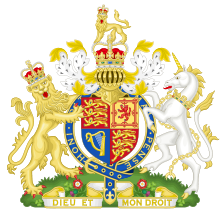
.svg.png)

